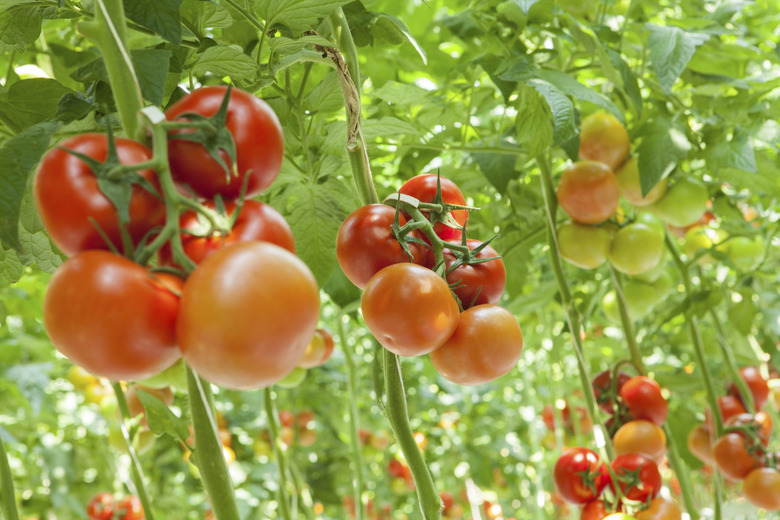How To Grow Tomatoes In 5-Gallon Buckets
A vegetable garden isn't complete without a tomato plant (Lycopersicon esculentum) or two, if only for the pleasure of fresh tomatoes in midsummer. Even if you don't have the space for a large garden, tomato plants are suited to container gardening. Which means that if you have a 5-gallon bucket or two hanging around, you have the makings for a tomato garden.
Preparing the Buckets
Wash and sterilize buckets, even if they're new, with a solution of 2 tablespoons household bleach in 1 gallon of water, and allow them to air-dry. Drill 1/4- to 1/2-inch holes on the lower edge of the bucket for drainage, spacing them about 2 inches apart all the way around. Place a 2-inch layer of coarse gravel or small stones in the bottom to prevent water from pooling, should the holes get plugged with soil.
Soil Choices
Growing mixes specifically designed for tomatoes go a long way toward minimizing the risk of soil-borne diseases, and provide the right conditions for proper root development. Not all potting soils are alike: Some are dense and wet, while others are fluffy but low in nutrients. Your best bet is to make your own, using equal parts potting soil, sphagnum or peat moss, and well-aged compost or manure. Fill the buckets to halfway and set aside the extra soil to fill in around the plants.
Planting Properly
Dig a hole in the center of the growing mix to equal the size of the seedling's roots. Set it gently into the hole and bring the soil around the base of the stem. Add more soil until it comes up to just below the seedling's lowest leaves and pat gently. Fertilize with a starter solution of 3 to 4 tablespoons of an 8-8-8 blend in 1 gallon of water, adding no more than 1 cup of the mixture to each plant. Fertilize again when the fruit appears, and every four to six weeks through the growing season.
Support Systems
Tomato plants can get top-heavy once the fruit starts to set. Install support in the form of a stake or a tomato cage into the bucket right after planting. Poke the stake into the soil about 2 inches from the plant so you don't injure the roots. As the plant grows, attach it loosely to the stake with gardening twine or tomato clips. Insert a tomato cage into the soil up to the bottom rungs, and tuck the branches in as the plant grows.
General Care
Buy seedlings from a garden center, or start your own indoors in early spring. Transfer them outside when they are about 4 to 6 inches tall and when it is at least 50 degrees Fahrenheit with no chance of frost. Place the buckets in a sunny spot, and inspect your tomato plants routinely for signs of fungal disease. Symptoms include dark, dead plant tissue, spots on the leaves and fruit, and fuzzy mildews on leaves and stems. Treat the plants with a solution of 1/2 to 2 ounces of liquid copper and 1 gallon of water, or according to label instructions. Spray all parts of the tomoatoes, including both sides of the leaves, when the disease appears, and every seven to 10 days until symptoms disappear.
References
- The University of Maine Cooperative Extension: Growing Vegetables in Container Gardens
- Fine Gardening: How to Grow Tomatoes in Containers
- Ohio State University Extension: Growing Cucumbers, Peppers, Squash and Tomatoes in Containers
- Penn State University Cooperative Extension: Growing Great Container Vegetables: Tomatoes
- Missouri Botanical Garden: Lycopersicon Esculentum
